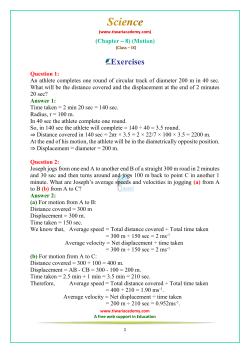
Distance vs. Displacement Distance â is the total distance that an
Distance vs. Displacement (Go to the following website for more help on distance and displacement) http://www.physicsclassroom.com/class/1dkin/u1l1c.cfm Distance ‐ is the total distance that an object has moved, no matter what direction the object travelled in Displacement ‐ is the distance that an object moves from its starting point, and includes direction. Example: Adam rides his bike 14 km North and then turns around and bikes 20 km South. What distance did Adam travel? What is Adam’s displacement? ‐‐‐‐‐‐‐‐‐‐‐‐‐‐‐‐‐‐‐‐‐‐‐‐‐‐‐‐‐‐‐‐‐‐‐‐‐‐‐‐‐‐‐‐‐‐‐‐‐‐‐‐‐‐‐‐‐‐‐‐‐‐‐‐‐‐‐‐‐‐‐‐‐‐‐‐‐‐‐‐‐‐‐‐‐‐‐‐‐‐‐‐‐‐‐‐‐‐‐‐‐‐‐‐‐‐‐‐‐ Scalar vs. Vector Quantities (Go to the following website for more help with scalars and vectors) http://www.physicsclassroom.com/class/1dkin/u1l1b.cfm Scalar ‐ a quantity that does not have a direction associated with it. Examples: Time, mass, distance, speed Distance travelled by and object does not include the direction travelled. Speed of an object does not include the direction travelled. Vector ‐ a quantity that does have a direction associated with it. Examples: displacement, velocity, acceleration is the distance and direction an object is away from a starting point. Displacement . Velocity of an object includes the direction that an object travels. . 1 2
© Copyright 2025




















